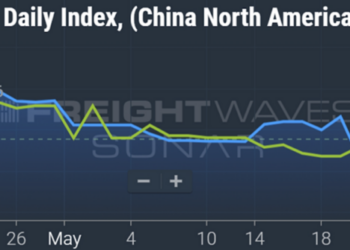Weather experts say this year’s typhoon season has been the most disruptive. According to Everstream Analytics, the most disruptive storms this season and the areas most affected have been Gaemi (Taiwan and China), Ampil (Japan), Shanshan (Japan), Yagi (Philippines, China, Vietnam), and Bebinka (China). These storms have had a significant impact on port operations.
Jon Davis, chief meteorologist for Everstream Analytics, tells FreightWaves that along with the disruptions to port operations, shipping across the western Pacific has been impacted via delays and increased congestion. He warns the Gulf Coast should be on high alert this week.
“The Gulf of Mexico will have significant issues … as a potentially strong hurricane develops and moves northward across the Gulf of Mexico impacting the U.S. Gulf Coast [late this week] or over the weekend of September 28-29,” Davis forecast. “The ports along the U.S. Gulf Coast should be on high alert for issues … .”
But these highly destructive tropical cyclones impact more than the ports and ship arrivals. The storms can also affect the volume of bulk and freight that can be moved along the waterway superhighway.
Trade takes people and can destroy the products they make. The world of trade is reliant on the transport of products/commodities. Typhoons have impacted some of those trade volumes. For the agricultural trade, Typhoons can be devastating for crops, which means the bulk industry can be affected with less product to move.
According to the U.S. Department of Agriculture, Taiwan’s loss of crops from Typhoon Gaemi was a whopping estimated $58.3 million. With the addition of livestock and fish production, the estimated loss exceeds $86 million. The affected area spans 23,060 hectares, with a damage severity of 27%, translating to 6,305 unharvestable hectares.
“The crops most impacted include bananas, guavas, oranges, bamboo shoots, and pears. These crops were particularly vulnerable due to strong winds and heavy rains, which caused physical damage, waterlogging, and increased risk of fungal infections. Typhoon Gaemi swept through Taiwan July 24-25, 2024, causing widespread flooding and damage to agriculture particularly in the Southern part of Taiwan,” said the USDA report.
Taiwan is the United States’ sixth-largest export market for U.S. food and agricultural products, according to the USDA.
The other known fact of typhoons is the devastating impact of the gale-force winds and heavy rain. Industrial production can be halted for weeks, there are mass evacuations, and casualties are reported. Airports close. Inland transportation and cargo storage can be impacted if railway services are ever halted or if there is flooding and damage to the road and rail networks. On the water, ports are closed, vessels are anchored, and port congestion increases.
But even with this turmoil, Ilya Preston, CEO of Paxafe, says navigating the turbulent typhoon risk is not always clear, and it’s important to quantify the risk across your mitigating options.
“You have to ask yourself, how are my 2nd and 3rd route options performing recently and have I made the best packaging decisions on this route?” said Preston. “Are there cost or CO2 considerations which could influence my decisions? These are the types of questions that need to be asked and answered quickly and can have an enormous impact on how shippers fare during weather-related disruptions. Data generated by today’s supply chains allow for enterprises to quickly assess many complex decision factors and make the best fact-based decision each time.”
The Intergovernmental Panel on Climate Change (IPCC), the United Nations body assessing the science related to climate change, has warned that while the number of tropical cyclones around the world is unlikely to increase, a storm’s intensity may increase as the world warms.
So, what does this mean for shippers? You need to make sure you have a strong business continuity plan and build your supply chain resilience. The climate challenges facing the world have created many bottlenecks worldwide.
Typhoon Yagi-related economic losses in Vietnam are in the billions. The Red River Delta — a vital agricultural region for Vietnam, is also the location of manufacturing hubs. In Myanmar, the U.N.’s World Food Program said the deadly floods the Typhoon created were the worst in the country’s recent history.
These storms impact the entire ecosystem of trade. The recovery from the storms is vital to a thriving logistics world.
The post Typhoons causing billions in agricultural losses, disrupt global supply chains appeared first on FreightWaves.














